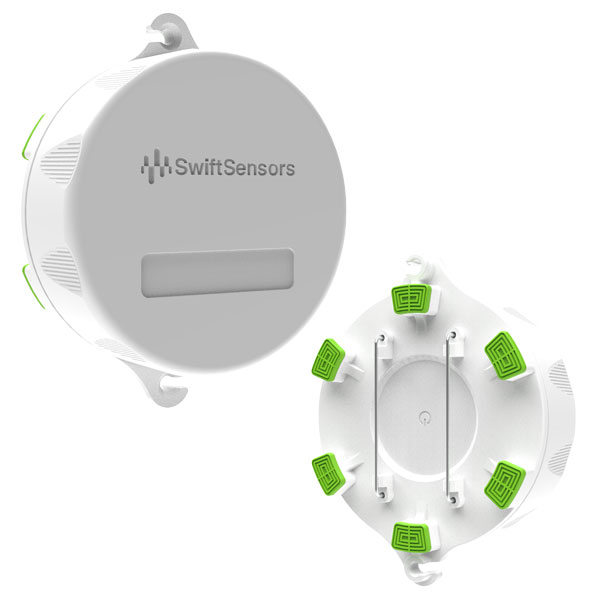Water Leak Detection is Critical
Water leak detection is critical in various industries such as restaurants, schools, manufacturing, commercial property, residential property, medical facilities and more. In these sectors, unintended water presence can mean costly damages, disruption of operations, displacement of people, and potential health hazards. Swift Sensors, the leading company in wireless sensor technology, offers simple wireless sensor solutions for water detection. But how do these water detection sensors actually work? Let’s delve into the intricacies of this technology.
The Basic Principle
Water detection sensors operate based primarily on the conductivity of water. When two conductive elements come in contact with water, a circuit is completed, which triggers an alarm. The design is generally simple: two exposed conductive probes (often made of metal) are positioned at a certain distance from each other. In the absence of water, there’s no connection between them. However, when water bridges the gap, its inherent conductive properties complete the circuit, activating the sensor.
How it Works
A wireless water detection sensor works by using technology to monitor areas for the presence of water and alert property owners or managers in case of leaks or flooding.
Typically, these sensors consist of two main parts: the sensor itself, which detects water, and a wireless transmitter.
The sensor part usually includes probes or detection circuits that are sensitive to moisture. When water comes into contact with these probes, it completes an electrical circuit, signaling the presence of water. This trigger is detected by the sensor’s internal mechanism, which then triggers an alert.
The wireless aspect of the sensor comes into play for the transmission of the alert. Once the presence of water is detected, the sensor sends a signal using wireless technology such as Wi-Fi, Bluetooth, or a dedicated wireless protocol through a local gateway (router device) up a central cloud system or directly to a user’s smartphone or computer.
This immediate notification allows for a quick response, potentially preventing significant water damage. Some advanced sensor systems such as Swift Sensors have APIs which allow integration into broader building automation or industrial monitoring systems, making them a part of the Internet of Things (IoT) ecosystem.

Types of Water Detection Sensors
Spot-Type Sensors: These sensors detect water at specific locations. They’re perfect for areas where water accumulation begins, such as the base of water heaters or under sinks in restaurants. These sensors are compact and can be installed at any desired spot.
Rope-Type Sensors: Unlike spot sensors that monitor specific points, rope-type sensors can detect water presence along their length. They’re ideal for perimeter monitoring, such as around the edges of a room or across wide areas in manufacturing units. The rope is typically embedded with multiple conductive threads and when any part of it contacts water, the sensor is triggered.
Puck-Type Sensors: This easy-to-deploy sensor is ideal for detecting water leaks and flooding. The puck sensor can be mounted or simply placed on the floor or in the base of a cabinet.
Water Detection and IoT
What makes Swift Sensors a leader in this domain is the seamless integration of these sensors with wireless technology. When the sensor detects water, it can immediately transmit this data wirelessly, allowing for real-time alerts to be sent to decision-makers via SMS, email, or app notifications.
This ensures immediate action can be taken, minimizing the potential for damage or disruption. Furthermore, the data collected can be stored and analyzed to uncover potential issues before they occur.
A wireless water detection sensor represents a key component of the Internet of Things (IoT), as it connects to a network to provide real-time data monitoring and alerting for water presence or leakage.
Applications in Different Industries
-
Restaurants. In a restaurant, a water leak can not only damage infrastructure but also disrupt operations and compromise food safety. Installing water detection sensors in kitchens, restrooms, and basements ensures that any leakage is promptly detected and addressed.
-
Schools. Schools with laboratories, restrooms, and large heating systems can benefit from water detection sensors. An unnoticed leak can cause widespread damage and lead to mold growth, causing potential health concerns. Wireless sensors can alert decision-makers to water leaks, even during school holidays and breaks.
-
Manufacturing. In manufacturing units, water intrusion can damage machinery, disrupt operations, and even pose safety risks. Sensors ensure that any such anomalies are detected quickly, ensuring maintenance technicians can act immediately.
-
Medical Facilities. Modern medical facilities have millions of dollars worth of equipment in sterile environments. Swift Sensors’ water detection solutions offer peace of mind by ensuring that any water presence is promptly detected.
-
Commercial Properties. A water leak in a commercial property often disrupts business operations or displaces tenants. The cost is usually passed on to the property owner. A leak that occurs on weekend or holiday can go unnoticed. A wireless water detection sensor system can send instant alerts 24/7, ensuring attention is brought to the water leak quickly, even during off hours.
Final Thoughts
The functionality and versatility of water detection sensors make them indispensable in today’s world, especially in sectors where the smallest water intrusion can have significant consequences. By understanding their workings and applications, businesses can make informed decisions to protect their infrastructure, ensure continuity, and guarantee safety. As industries continue to evolve, the role of sophisticated solutions like those offered by Swift Sensors becomes even more crucial.

